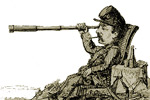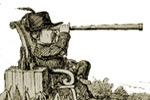
STOP #7
JACK'S MOUNTAIN SIGNAL STATION |
The exact location of the Jack's Mountain signal station is not
known. However, this location gives you a sense of the panoramic view which was
available to the signal team operating on this mountain. Take your compass and
orient yourself by sighting the National Tower at 70 degrees. Now you can find
Little Round Top at 73 degrees. Looking to the left you can see the dome of the
Pennsylvania monument and the obelisk of the Congressional monument. Realizing
that there was less timber on the field in 1863, you can see that a signal team
on this mountain would have had a clear view of troop movements.
This station was occupied by Capt. C. S. Kendall and Lieut. L. R. Fottescue
who were ordered here by Capt. Norton when he was at Emmitsburg enroute to the
battlefield. They were able to establish flag signals with Taneytown but were
never successful in opening flag signals with the Little Round Top station.
Confederate troop movements were visible to include the initial formations
massing for Pickett's Charge. This information was signaled to Taneytown but not
to the Round Top station. The signalmen at Little Round Top were clearly visible
and Lieut. Fortescue sent a courier to the battlefield to tell Capt. Norton that
the team could see the Round Top station.
[J. Willard Brown, Signal Corps, U.S.A. in the War of the Rebellion,
New
York, Arno Press, 1974, p. 370]
The information which could have been made available to the Commanding
General if the signal officers were more aggressive in contacting each other
might have influenced the action. The lack of control exercised by Capt. Norton
over the various stations was a limiting factor in the effectiveness of the
Signal Corps at this stage in the campaign.
After the battle was over, Capt. Kendall and Lieut. Fortescue were captured
by the Confederates. J. Willard Brown, the historian of the U.S. Veteran Signal
Corps Association, tells the interesting story:
On Saturday morning, July 4th, at about 6 o'clock, a farmer rode
up to the station and hurriedly informed the signal party there stationed that
the rebel cavalry (a squad of about twenty) were coming down the Millerstown
Pike, intending to capture them, that they had fed and watered their horses at
his place during the night, and had been heard to refer to the signal flag,
which they remarked would be looked after at daylight.
Being thoroughly satisfied of the truth of this report from the numerous
cavalry squads seen on the pike, the signalmen were soon in their saddles and
were shown a road not much frequented, which led them to the Millerstown road
near Emmitsburg. Arriving at the latter town, they made a detour of the
Catholic College and were soon galloping hard for Taneytown. Later in the day,
when near the latter place, they met the advance of Kilpatrick's Division of
cavalry going in the direction of Emmittsburg, and, as they had received no
orders to leave their station, they returned with them to again occupy it.
When they reached the town it was dark and raining quite hard, a night
wholly impracticable for signalling, but with the hope that it might clear
away they dismounted under a shed and awaited the rear the cavalry then slowly
passing through the town. At twelve o'clock, the last of them had passed.
They had been informed by members of Kilpatrick's staff that Lee's entire
army had retreated through the Montery or Fairfield Gap, and that our army
would advance at daylight. Acting upon this information, not having had a word
from Capt. Norton, and realizing the impossibility of using torches or of
seeing the opposite station in such a rain, as well as the extreme probability
of a change of stations owing to Lee's repulse, they turned into a barn near
the foot of the mountain, stationed a man on guard near the road, while
Kendall and Fortescue made a bed on the floor of the house adjoining.
Before daylight, Stuart's cavalry having been cut off by Kilpatrick, who
occupied the gap in Lee's rear, commenced retreating southward to find an
unoccupied gap, and, although the enemy's cavalry were on the roads all around
them within three hours after they had lain down, the guard did not recognize
the rebels but supposed them to be Kilpatrick's men.
As daylight dawned, he discovered his mistake and awoke the rest of the
party, but too late. The thieving propensity of the rebel cavalry for
horseflesh soon led them to the barn, and before very long the signal
detachment had taken up the line of march for Richmond.
[J. Willard Brown, Signal Corps, U.S.A. in the War of the Rebellion,
New
York, Arno Press, 1974, pp. 370-371.]
The conduct of signal
officers had become a concern to the Chief Signal Officer who issued a General
Order in June of 1863 which outlined a "code of conduct." There had been cases
where the actions of signal officers had caused panic and confusion within the
Army, and this order is interesting in that it not only prescribe conduct to
prevent over-reaction from exaggerated reports but also outlines proper conduct
in the face of the enemy to prevent capture or compromise of equipment or
information which would have an intelligence value to the enemy.
General Order issued by Col Albert J. Myer, Chief Signal Officer,
U.S. Army
General Orders, OFFICE OF THE SIGNAL OFFICER,
No.9, Washington, D.C., June 26, 1863.
- It having come to the knowledge of the Signal Officer of the Army
that,in some instances officers of the Signal Corps have transmitted
information by signals of such a character as to produce alarm, uproar, and
confusion among troops, and the inhabitants of town or cities with which they
may be in communication, which reports have often been without foundation, the
officer thereby being guilty of conduct prejudicial to good order and military
discipline, it is hereby ordered and enjoined that all signal officers shall
be held fully responsible and amenable to the military regulations of the Army
for such stampede reports forwarded without foundation or forethought of this.
- Under all circumstances must officers corps be fully cognizant of the
responsibility resting upon them as proper and reliable sources of information
or means of communications, such information being in most cases for the use
of the commanding general or other officers commanding troops, and being the
foundation of important movements or operations of the Army or Navy.
- Reports must be make fully, concise, and clear, detailing all
important discoveries, such as movements of the enemy, direction taken,
probable numbers, whether artillery, cavalry, or infantry, and their position
taken by compass from the station of observation. They must be made quietly,
and written or delivered without the slightest exaggeration or excitement.
- Should the enemy be discovered advancing toward an officer or station,
the signal party must not fall back until it is absolutely necessary to
prevent capture, previously reporting to headquarters the advance of the
enemy, and then a retreat must be effected quietly, and as much under cover as
possible, taking care to create no needless alarm.
- Every precaution must be taken that no signal apparatus, glasses, or
papers of any description fall into the hands of the enemy. If necessary to
prevent capture, everything will be destroyed.
- Chief signal officers of departments-or army corps are required to see
that the provisions of this order are fully carried out and that it is
promulgated to every officer of the detachment. Nothing gives to commanding
generals greater confidence in their informants than to see that they at least
are not in the slightest degree excited, stampeded, or alarmed.
- It is designed that the officers and men of this corps shall become
known and noticed throughout the Army for their bravery, coolness, and
reliability under the most trying circumstances. Every officer not only bears
upon himself the responsibility of sustaining his individual honor and
reputation, but the honor of a corps performing its duties in the dangerous
undertaking of establishing stations of observation and communication almost
within the lines of the enemy and amid all the perils of the battlefield.
By order of the Signal Officer of the Army:
HENRY S. TAFFT,
Captain and Signal Officer.
[O.R.,SERIES III-VOLUME III, pp. 417-418.]
Securing the
signal station from the enemy to prevent capture or the compromise of
information was a concern which was expressed in Col. Myer's A Manual.
Stations must be kept concealed from the enemy so far as is possible. On
stations of observation solely, no flags will be shown and no persons permitted
except those a ctually on duty. Every precaution will be taken to prevent the
enemy ascertaining the purpose for which the point is occupied. When
communication by signals is needed, the flag will be screened from observation,
if it can be, and in any case it will be shown only while t ransmitting messages
...
[Albert J. Myer, A Manual of Signals,
New York, D. Van Nostrand, 1868, p.
250.]
Now you should return to you automobile and drive to STOP 8.
Go back to JACK'S MOUNTAIN ROAD and turn LEFT. Drive 1.5 miles and turn left
on SR 16. Drive 6.4 miles to EMMITSBURG. Turn RIGHT at the stoplight and drive
0.5 miles to HWY 15. Turn RIGHT and drive 1.1 miles to MT. SAINT MARY'S COLLEGE.
Exit HWY 15 to the RIGHT and enter the parking lot of the college. Park by the
visitor's center. The signal site was on the hill which you can see directly
behind the college. You may ask in the visitors center for directions to the
hiking trail. The hill is open to the public. The hill is heavily timbered and
visibility is limited. You may wish to read the material here in the parking
lot.
|




